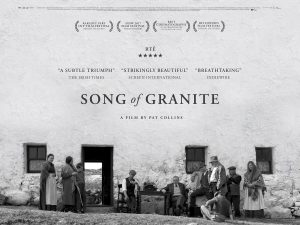Song of Granite (2017), was the opening film at this year’s Galway Film Fleadh. The film was introduced by the producer, Alan Maher (of Marcie Films), and the director, Pat Collins, who reminisced about his time as the Fleadh programmer in the 1990s. As this was the opening film, it screened to a full house, including cast and crew, as well as the featured musicians Lisa O’Neill and Damien Dempsey.The black and white, lán Gaeilge, Song of Granite is a portrait of the sean-nós singer, Joe Heaney.

It is difficult to define the film, and perhaps there is no need to try to do so – to fit it into clearly labelled folders of ‘genre’ and ‘format’. But there is a human tendency to desire classification, and an unfortunate necessity for entering film festivals, marketing and distribution. Although it was in competition with the feature films in the Galway Film Fleadh, it could just as easily be labelled as a documentary. The dramatic portions of the film could be termed reconstructions, common in drama-documentary. The film also incorporates archive film and audio footage, so in this way, it could be billed either as feature documentary or a feature film. The archive footage of Irish emigrants in Glasgow and the reconstructions of the lives of Irish-speaking men in the UK reminded me of two previous screenings: the documentary, Men of Arlington (dir. Enda Hughes) and the feature film, Kings (dir. Tom Collins). Both of these films address the lonely, lost lives of single Irish men who find themselves turning to drink while living in London. In Song of Granite, the images of sad urban lives in the UK contrasted with the freedom and open air of Conamara. There is a physical feeling of relief to get back to Conamara and breathe the open air again, after watching the pub interiors, and the UK.
The 13-year-old Colm Seoighe gave an impressive performance playing the young Joe Heaney, and reminded me of both a young Domhnall Gleeson and Cillian Murphy: Domhnall Gleeson in his colouring and his screen presence, and Cillian Murphy in his eyes and expression. Colm did not appear to be fazed by the camera and crew, perhaps due to the small crew size, but also likely a testament to the director’s skills in putting him at his ease. He is a fantastic young actor and I hope that he is encouraged to pursue acting as he gets older.
The most notable aspect of this film was the soundscape – the sound recording team and the sound editing team need to be commended. As is evidenced in Pat Collins’ previous film, Silence, sound is intrinsic to his work and sound design is key to Song of Granite also. There is a wealth of atmospheric and ambient sounds used, with the focus on the sea, nature and song – whereas dialogue is kept minimal. By suppressing the visual elements (dark scenes, suppression of light, monochrome), the senses are focussed on sound instead. At the same time, this is a highly cinematic, photographic film, deservedly winning an award for cinematography at the Fleadh this year. There is a dream-like quality to this film: it is beautifully shot, there is a wonderful atmosphere, it is restful – you can get carried along with the film with your imagination and drift away – however, there isn’t a narrative, in the traditional sense of a feature drama film. The viewerwould nearly need to know the story of Joe Heaney before watching, to understand what’s going on. The reconstructions are particulate and bitty, they don’t string together in a narrative structure – they are isolated reconstructed dramatisations. If you are a person who likes to watch a film for story, this might frustrate you. However, for me, the impressive acting of Colm Seoighe, the beautiful cinematography and the wonderful soundscape made this an enjoyable experience, and rose above the lack of a traditional narrative structure-which isn’t as important for me, personally.
While I imagine the previous screenings at Karlovy Vary and SXSW took on an ethnographic-cultural tone (for example, the filmmakers had to explain what sean-nós was in U.S. interviews ), in Galway, there was very much a sense of the film ‘coming home’. The Irish language was not a barrier to this audience, comprising of the film crew, Conamara-based cast and a who’s-who of the film and television industry in the west – with whom the landscape and lives portrayed resonated. The crowd was very responsive to the traditional music ‘sessions’ on screen, and some older audience members around me sang along to ‘The Galway Shawl’, which was a very sweet moment. After one long sean-nós session, the cinema audience applauded along with the on-screen audience, as they felt intimate with the scene.
Pat Collin’s Song of Granite transcends genre and strict, static definitions. I hope that he, as an Irish auteur, will be included in the canon of Irish filmmakers, and to see his work in ‘Irish film’ courses across Ireland and internationally.
Song of Granite is Ireland’s Oscar entry for ‘Best foreign language film’, and is released in Irish and UK cinemas on 24th Nov 2017.
Trailer: https://youtu.be/tcfPcLGxcoc
Awards:
Richard Kendrick was awarded Best Cinematography in an Irish Feature for Song of Granite.
Review originally printed in Film Ireland. Republished with permission of the author.

Just a couple of footnotes/comments as this was originally written with an Irish audience in mind!
*’lán Gaeilge’ means in the Irish language (Similar to the Gaelic language in Scotland)
*’Sean-nós’ is a type of traditional Irish solo singing, usually a lament. This is a clip of Joe Heaney singing sean nós https://www.youtube.com/watch?v=w8de27O8ILo . Although I think there is a similar style in the Gaelic traditions in the Islands & Highlands of Scotland.